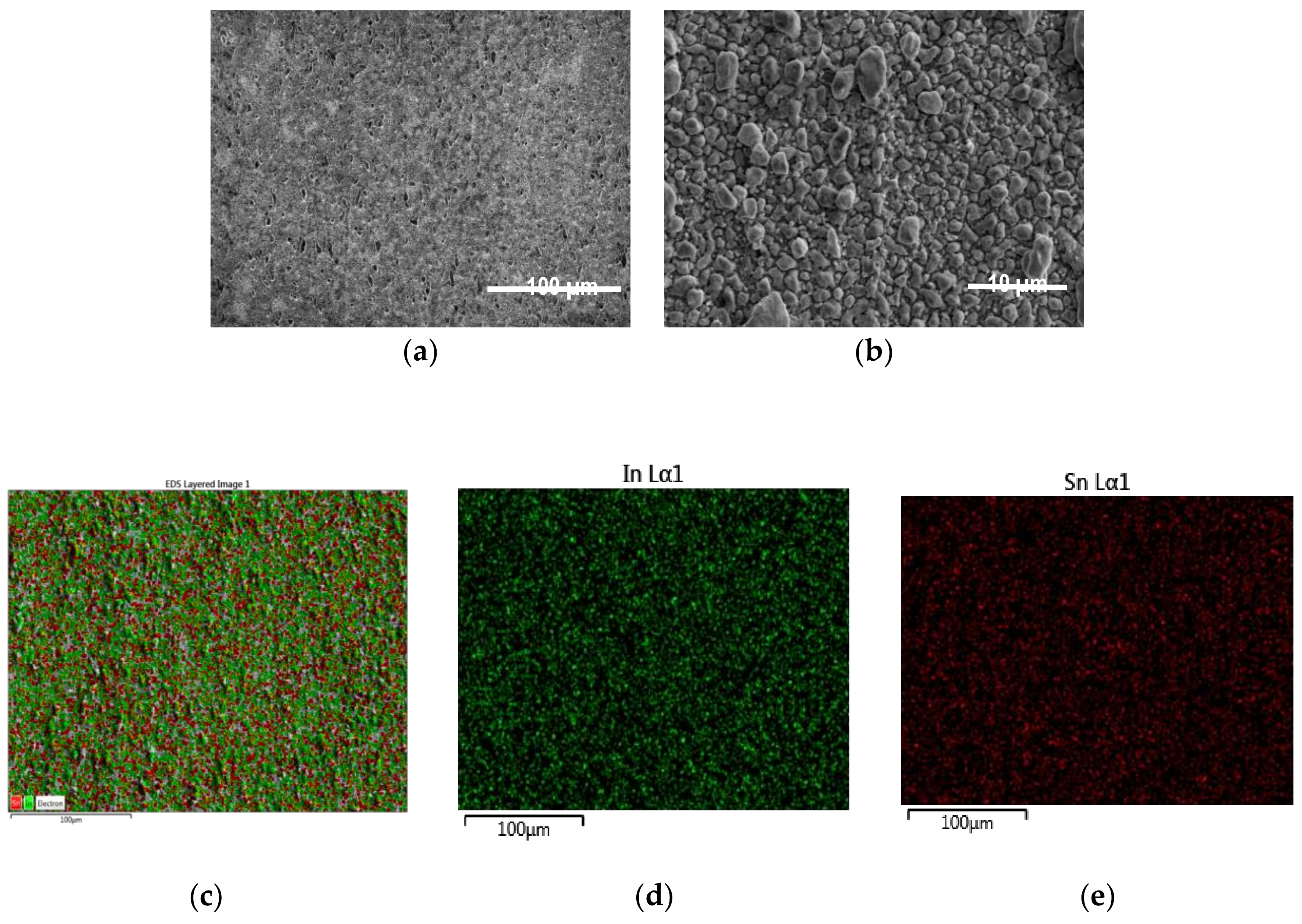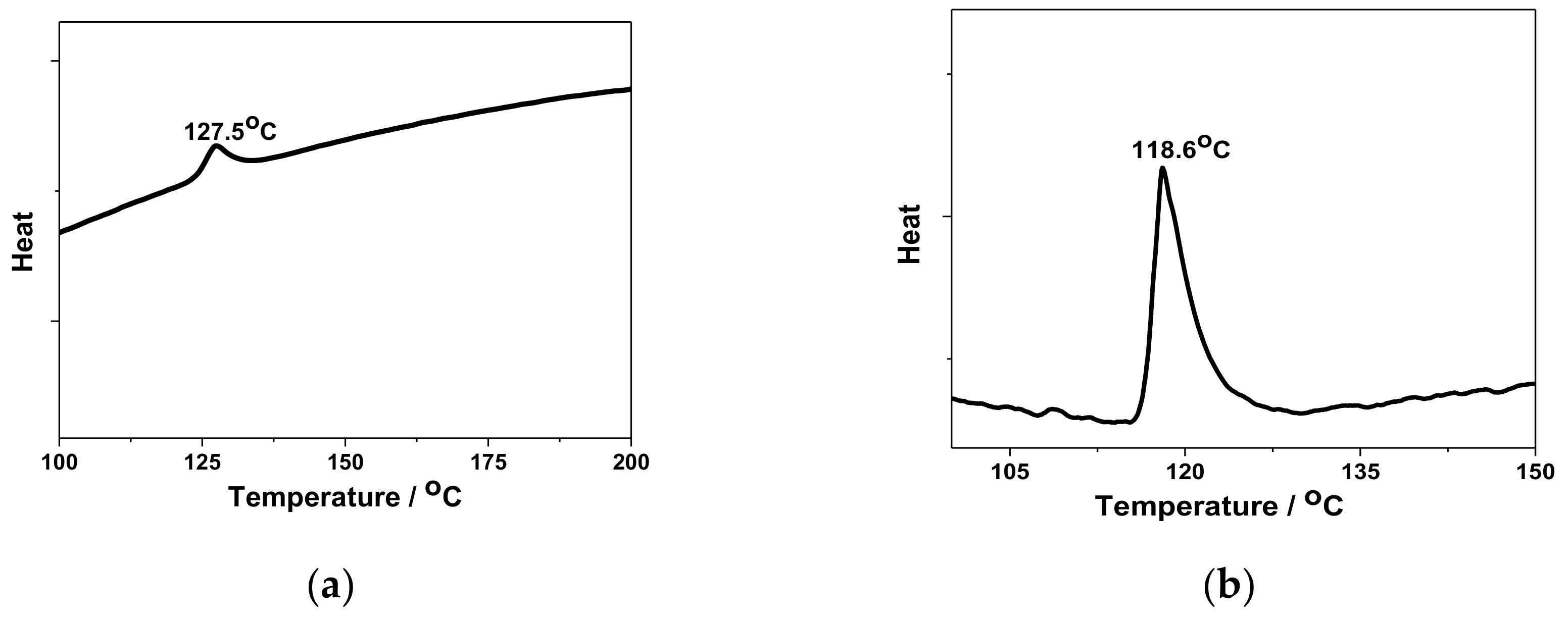Electrodeposition of Sn–In Alloys Involving Deep Eutectic Solvents
Abstract
:1. Introduction
2. Materials and Methods
3. Results and Discussion
3.1. Sn–In Alloy Coatings Characteristics
3.2. Solderability Tests
3.3. Corrosion Behavior of Sn–In Alloy Coatings Obtained from Deep Eutectic Solvents (DESs)
4. Conclusions
Author Contributions
Funding
Acknowledgments
Conflicts of Interest
References
- Directive 2002/95/EC of the European Parliament and of the Council. Available online: http://eurlex.europa.eu/LexUriServ/LexUriServ.do?uri=OJ:L:2003:037:0019:0023:EN:PDF (accessed on 25 October 2019).
- Cheng, S.; Huang, C.M.; Pecht, M. A review of lead-free solders for electronic applications. Microelectron. Reliab. 2017, 75, 77–95. [Google Scholar] [CrossRef]
- Qin, Y.; Wilcox, G.D.; Liu, C. Electrodeposition and characterisation of Sn-Ag-Cu solder alloys for flip-chip interconnection. Electrochim. Acta 2010, 56, 183–192. [Google Scholar] [CrossRef]
- Huang, J.T.; Chao, P.S.; Hsu, H.J.; Shih, S.H. A novel bumping process for fine pitch Sn-Cu lead-free plating-based flip chip solder bumps. Mater. Sci. Semicond. Process. 2007, 10, 133–142. [Google Scholar] [CrossRef]
- Yingxin, G.; Haseeb, A.S.M.A.; Sabri, M.F.M. Electrodeposition of lead-free solder alloys. Solder. Surf. Mt. Technol. 2013, 25, 76–90. [Google Scholar]
- Wislei, R.O.; Leandro, C.P.; Lenoardo, R.G.; Nathalie, M.; Amauri, G. Microstructure and mechanical properties of Sn-Bi, Sn-Ag and Sn-Zn lead-free solder alloys. J. Alloy. Compd. 2013, 572, 97–106. [Google Scholar]
- Zhang, R.; Zhang, J.; Evans, J.; Johnson, W.; Vardaman, J.; Fujimura, I.; Tseng, A.; Knight, J. Tin-Bismuth Plating for Component Finishes. In Proceedings of the IEEE 61st Electronic Components and Technology Conference (ECTC), Lake Buena Vista, FL, USA, 31 May–3 June 2011; pp. 2060–2066. [Google Scholar]
- Liu, L.; Xue, S.; Liu, S. Mechanical Property of Sn-58Bi Solder Paste Strengthened by Resin. Appl. Sci. 2018, 8, 2024. [Google Scholar] [CrossRef]
- Das Mahapatra, S.; Dutta, I. Co-electrodeposition of tin with 0.2–20% indium: Implications on tin whisker growth. Surf. Coat. Technol. 2018, 337, 478–483. [Google Scholar] [CrossRef]
- Jadhav, N.; Williams, M.; Pei, F.; Stafford, G.; Chason, E. Altering the mechanical properties of Sn films by alloying with Bi: Mimicking the effect of Pb to suppress whiskers. J. Electron. Mater. 2013, 42, 312–318. [Google Scholar] [CrossRef]
- Dimitrovska, A.; Kovacevic, R. The effect of micro-alloying of Sn plating on Sn whisker growth. J. Electron. Mater. 2009, 38, 2726–2734. [Google Scholar] [CrossRef]
- Leidecker, H.; Kadesch, J.S. Effects of Uralane conformal coating on tin whisker growth. In Proceedings of the 37th IMAPS Nordic Annual Conference, Helsingor, Denmark, 10–13 September 2000; pp. 108–116. [Google Scholar]
- Meinshausen, L.; Bhassyvasantha, S.; Majumdar, B.S.; Dutta, I. Influence of indium addition on whisker mitigation in electroplated tin coatings on copper substrates. J. Electron. Mater. 2016, 45, 791–801. [Google Scholar] [CrossRef]
- Das Mahapatra, S.; Majumdar, B.S.; Dutta, I.; Bhassyvasantha, S. Elimination of whisker growth in tin coatings by indium addition. J. Electron. Mater. 2016, 46, 4062–4075. [Google Scholar] [CrossRef]
- Medvedev, G.I.; Rybin, A.A.; Makrushin, N.A. Electrodeposition of tin-indium alloy from a sulfate electrolyte in the presence of organic substances. Russ. J. Appl. Chem. 2012, 85, 604–611. [Google Scholar]
- Nawafune, H.; Nakatani, T.; Akamatsu, K.; Mizumoto, S.; Obata, K.; Uchida, E. Electrodeposition of Sn-In Eutectic Alloy from Sulfosuccinate Bath for Flip-Chip Interconnection. Mater. Sci. (Jpn.) 2002, 5, 349–352. [Google Scholar]
- Qin, Y.; Flajslik, K.; Sherzer, B.; Banelis, E.; Lee, I.; Cho, R.; Grippo, L.; Imanari, M.; Lefebvre, M.; Wei, L.; et al. Enabling Low-Temperature Bonding in Advanced Packaging using Electrodeposited Indium. In Proceedings of the IEEE 66th Electronic Components and Technology Conference (ECTC), Las Vegas, NV, USA, 31 May–3 June 2016; pp. 2151–2156. [Google Scholar]
- Lyon, S.B. Corrosion of tin and its alloys. In Shreir’s Corrosion, 4th ed.; Elsevier B.V.: Amsterdam, The Netherland, 2010; Volume 3, pp. 2068–2077. [Google Scholar]
- Kim, H.; Lee, H.; Lim, T.; Ahn, S.H. Facile fabrication of porous Sn-based catalysts for electrochemical CO2 reduction to HCOOH and syngas. J. Ind. Eng. Chem. 2018, 66, 248–253. [Google Scholar] [CrossRef]
- Lai, Q.; Yang, N.; Yuan, G. Highly efficient In–Sn alloy catalysts for electrochemical reduction of CO2 to formate. Electrochem. Commun. 2017, 83, 24–27. [Google Scholar] [CrossRef]
- Ota, J.; Ishikawa, K.; Kosakai, K. Plating of indium-tin alloy. J. Metal Finish. Soc. Jpn. 1965, 16, 246–250. [Google Scholar] [CrossRef]
- Medvedev, G.I.; Rybin, A.A.; Makrushin, N.A. Leveling power of sulfate electrolytes with organic in electrodeposition of tin–indium alloy. Russ. J. Appl. Chem. 2013, 86, 351–354. [Google Scholar]
- Ozga, P.; Swiatek, Z.; Michalec, M.; Onderka, B.; Bonarski, J. Phase structure and texture of electrodeposited InSn alloys on copper substrate. Arch. Metall. Mater. 2008, 53, 307–315. [Google Scholar]
- Shaban, M.; Kholidy, I.; Ahmed, G.M.; Negem, M.; Abd El-Salam, H.M. Cyclic voltammetry growth and characterization of Sn–Ag alloys of different nanomorphologies and compositions for efficient hydrogen evolution in alkaline solutions. RSC Adv. 2019, 9, 22389–22400. [Google Scholar] [CrossRef]
- Abbott, A.P.; Alhaji, A.I.; Ryder, K.S.; Horne, M.; Rodopoulos, T. Electrodeposition of copper-tin alloys using deep eutectic solvents. Trans. IMF 2016, 94, 104–113. [Google Scholar] [CrossRef]
- Endres, F.; Abbott, A.P.; MacFarlane, D.R. Electrodeposition of Metals Using Ionic Liquids; Wiley-VCH: Weinheim, Germany, 2008. [Google Scholar]
- Wang, P.K.; Lin, W.J.; Sun, I.W. A glance of the electrochemical co-deposition of indium and arsenic in a choline chloride/ethylene glycol deep eutectic solvent. J. Electrochem. Soc. 2019, 166, D374–D380. [Google Scholar] [CrossRef]
- Abbott, A.P.; Boothby, D.; Capper, G.; Davies, D.L.; Rasheed, R.K. Deep eutectic solvents formed between choline chloride and carboxylic acids: Versatile alternatives to ionic liquids. J. Am. Chem. Soc. 2004, 126, 9142–9147. [Google Scholar] [CrossRef] [PubMed]
- Abbott, A.P.; Boothby, D.; Capper, G.; Davies, D.L.; Rasheed, R.K. Ionic liquid analogues formed from hydrated metal salts. Chem. Eur. J. 2004, 10, 3769–3774. [Google Scholar] [CrossRef] [PubMed]
- Abbott, A.P.; McKenzie, K.J. Application of ionic liquids to the electrodeposition of metals. Phys. Chem. Chem. Phys. 2006, 8, 4265–4279. [Google Scholar] [CrossRef] [PubMed]
- Gao, Y.; Hu, W.; Gao, X.; Duan, B. Electrodeposition of SnBi coatings based on deep eutectic solvent. Surf. Eng. 2014, 30, 59–63. [Google Scholar] [CrossRef]
- Anicai, L.; Petica, A.; Costovici, S.; Prioteasa, P.; Visan, T. Electrodeposition of Sn and NiSn alloys coatings using choline chloride based ionic liquids—Evaluation of corrosion behavior. Electrochim. Acta 2013, 114, 868–877. [Google Scholar] [CrossRef]
- Abbott, A.P.; Capper, G.; McKenzie, K.J.; Ryder, K.S. Electrodeposition of zinc-tin alloys from deep eutectic solvents based on choline chloride. J. Electroanal. Chem. 2007, 599, 288–294. [Google Scholar] [CrossRef]
- Barrado, E.; Garcia, S.; Rodriguez, J.A.; Castrillejo, Y. Electrodeposition of indium on W and Cu electrodes in the deep eutectic solvent choline chloride-ethylene glycol (1:2). J. Electroanal. Chem. 2018, 823, 106–120. [Google Scholar] [CrossRef]
- Alcanfor, A.A.C.; dos Santos, L.P.M.; Dias, D.F.; Correia, A.N.; de Lima-Neto, P. Electrodeposition of indium on copper from deep eutectic solvents based on choline chloride and ethylene glycol. Electrochim. Acta 2017, 235, 553–560. [Google Scholar] [CrossRef]
- Malaquias, J.C.; Steichen, M.; Thomassey, M.; Dale, P.J. Electrodeposition of Cu–In alloys from a choline chloride based deep eutectic solvent for photovoltaic applications. Electrochim. Acta 2013, 103, 15–22. [Google Scholar] [CrossRef]
- Malaquias, J.C.; Steichen, M.; Dale, P.J. One-step electrodeposition of metal precursors from a deep eutectic solvent for Cu (In, Ga) Se2 thin film solar cells. Electrochim. Acta 2015, 151, 150–156. [Google Scholar] [CrossRef]
- Nakahara, Y.; Morimitsu, M.; Matsunaga, M. Electrodeposition of In-Sn alloys in EMI-BF4-Cl molten salts. In Proceedings of the Electrochemical Society, 206th ECS Meeting, Honolulu, HI, USA, 3–8 October 2004; Volume 2004, pp. 861–865. [Google Scholar]
- Morimitsu, M.; Nakahara, Y.; Matsunaga, M. Electrodeposition of In-Sn alloys from EMI-BF4-Cl melts. Electrochemistry 2005, 73, 754–757. [Google Scholar] [CrossRef]
- Noda, M.; Morimitsu, M.; Matsunaga, M. Electrodeposition of In-Sn alloys in EMI-BF4-Cl ambient temperature melts with current pulses. ECS Trans. 2007, 3, 249–252. [Google Scholar]
- IPC-TM-650 Procedure 2.1.1 rev.F- Micro-Sectioning. Available online: http://www.ipc.org/TM/2-1-01F.pdf (accessed on 25 October 2019).
- IPC-610E- Acceptability of Electronic Assemblies. Available online: http://www.ipc.org/TOC/IPC-A-610E.pdf (accessed on 25 October 2019).
- IPC-TM-650, Method 2.2.5 -Dimensional Inspections Using Microsections. Available online: http://www.flex-plus.com/Upload/%E4%B8%8B%E8%BD%BD%E4%B8%AD%E5%BF%83/IPCTM650-14370777531.pdf (accessed on 20 November 2019).
- Ghosh, S.; Ryder, K.; Roy, S. Electrochemical and transport properties of ethaline containing copper and tin chloride. Trans. IMF 2013, 92, 41–46. [Google Scholar] [CrossRef]
- Maharaja, J.; Raja, M.; Mohan, S. Pulse electrodeposition of Cr–SWCNT composite from choline chloride based electrolyte. Surf. Eng. 2014, 30, 722–727. [Google Scholar] [CrossRef]
- Manolova, M.; Böck, R. Electrodeposition of Pd from a deep eutectic solvent system: Effect of additives and hydrodynamic conditions. Trans. IMF 2019, 97, 161–168. [Google Scholar] [CrossRef]
- Manolova, M.; Böck, R.; Scharf, I.; Mehner, T.; Lampke, T. Pulse plating of Pd–Ag alloy films from deep eutectic solvents. Surf. Eng. 2019, 35, 1081–1087. [Google Scholar] [CrossRef]
- Humpston, G.; Jacobson, D.M. Indium solders. Adv. Mater. Proc. 2005, 4, 45–47. [Google Scholar]
- Osórioa, W.R.; Spinelli, J.E.; Afonso, C.R.M.; Peixoto, L.C.; Garcia, A. Microstructure, corrosion behaviour and microhardness of a directionally solidified Sn–Cu solder alloy. Electrochim. Acta 2011, 56, 8891–8899. [Google Scholar] [CrossRef]









| Electrolyte Type | Electrolyte Composition | Temperature/°C |
|---|---|---|
| ILEG-SnIn | 0.05 M InCl3 + 0.05 M SnCl2·2H2O 0.1 M InCl3 + 0.05 M SnCl2·2H2O 0.1 M InCl3 + 0.03 M SnCl2·2H2O in ILEG | 20–60 |
| Immersion Time/h | Rct/Ω |
|---|---|
| 0 | 32,807 |
| 24 | 8715 |
| 144 | 7658 |
| 216 | 14,290 |
| 360 | 34,607 |
© 2019 by the authors. Licensee MDPI, Basel, Switzerland. This article is an open access article distributed under the terms and conditions of the Creative Commons Attribution (CC BY) license (http://creativecommons.org/licenses/by/4.0/).
Share and Cite
Anicai, L.; Petica, A.; Costovici, S.; Moise, C.; Brincoveanu, O.; Visan, T. Electrodeposition of Sn–In Alloys Involving Deep Eutectic Solvents. Coatings 2019, 9, 800. https://doi.org/10.3390/coatings9120800
Anicai L, Petica A, Costovici S, Moise C, Brincoveanu O, Visan T. Electrodeposition of Sn–In Alloys Involving Deep Eutectic Solvents. Coatings. 2019; 9(12):800. https://doi.org/10.3390/coatings9120800
Chicago/Turabian StyleAnicai, Liana, Aurora Petica, Stefania Costovici, Calin Moise, Oana Brincoveanu, and Teodor Visan. 2019. "Electrodeposition of Sn–In Alloys Involving Deep Eutectic Solvents" Coatings 9, no. 12: 800. https://doi.org/10.3390/coatings9120800
APA StyleAnicai, L., Petica, A., Costovici, S., Moise, C., Brincoveanu, O., & Visan, T. (2019). Electrodeposition of Sn–In Alloys Involving Deep Eutectic Solvents. Coatings, 9(12), 800. https://doi.org/10.3390/coatings9120800





